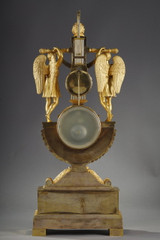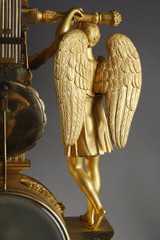An important Empire period gilt-bronze regulator clock. It is lyre-shaped with seven strings and bears the bust of Homer crowned with laurels. The finely chased gilt-bronze façade is decorated in its lower section with a mythological scene depicting Homer and a young boy within an oval cartouche, flanked by attributes such as military trophies, palmettes, heart-shaped motifs, laurel wreaths, and censers. The central, semicircular section of the clock, decorated with linear motifs of braids, acanthus leaves, and six stars surrounded by laurel wreaths, rests on a console base with curved volutes. The compensated pendulum movement is supported at the rear by a bust of the poet Homer, itself raised by two allegorical figures, probably Justice bearing a sword and Victory holding a palm branch. The whole rests on a plinth with four small, swashbuckling feet adorned with rosettes and finials. The lobed dial of acanthus leaves, marked "Gallien à Paris", displays the hours in Roman numerals.
Circa: 1810
Base dimensions: 28.5 cm x 12 cm (11.22 in x 4.72 in)
Total dimensions: L: 28.5cm, D: 12cm, H: 70cm.
Total dimensions: W: 11.2in, D: 4.7in, H: 27.6in.
Condition report: In good overall condition. The mechanism has been cleaned, serviced and is in working order.
Gallien in Paris
Matthieu Gallien was a bronze manufacturer established in Paris at 93 Rue de la Verrerie at the end of the 18th century. In 1809, under the name "Au Maître de tout" (To the Master of Everything), he hired a certain Louis-Isidore Choiselat, whom he married to his eldest daughter. Upon the master's death, Louis-Isidore took over the business, which became Choiselat-Gallien, "Au Maître de tout, Fabricant de Bronzes, Doreur et Argenteur" (To the Master of Everything, bronze manufacturer, gilder and silversmith). In 1815, he received the title of bronze manufacturer to Monsieur, the king's brother, for his regular rentals of candlesticks and candelabra. In January 1816, he obtained the patent to supply ornaments for the king's churches and chapels. He received numerous commissions from royal and noble circles for both churches and residences.
Documentation:
- KJELLBERG Pierre, Encyclopedia of the French clock from the Middle Ages to the 20th century , Paris, Les éditions de l'amateur, 1997.
- Reference :
- 3277
- Width :
- 29 (cm)
- Height :
- 70 (cm)
- Depth :
- 12 (cm)
- Identify Exists:
- False
















































